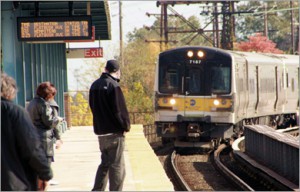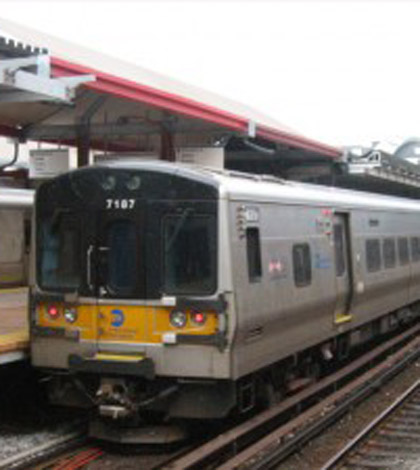
Taking the Long Island Rail Road further along into the 21st century could transform Long Island and revitalize the region, says Nancy Rauch Douzinas, president of the Rauch Foundation, a civic-minded non-profit group which just released its latest Long Island Index report at an event held at Molloy College in Rockville Centre on Tuesday.
“The Long Island Rail Road is one of Long Island’s top assets,” Rauch told the audience, with “potential to be transformative.”
“Our goal is to look at the railroad differently,” she said.
For 10 years her foundation’s annual Long Island Indexes have been providing the Island’s “civic, academic, labor and business leaders” with “useful, unbiased information that will lead to greater community awareness of Long Island issues and to serve as a catalyst for action,” as the organization says on its website. Or as Rauch said from the stage of the college’s Madison Theatre: “Using the facts to think smart.”
This year the Index is called “The Long Island Rail Road: From Moving Commuters to Shaping the Next Economy.” During her presentation, Ann Golob, director of the Index, called the railroad “one of the great underutilized assets of Long Island.” As it is, she noted, the LIRR’s commuters to the city add an estimated $26 billion to Long Island’s economy, while taking more than 100,000 drivers off our major already congested arteries into Manhattan—which became a huge factor after Superstorm Sunday knocked the LIRR out of service for a week.
Making her case, Golob cited how Metro-North has helped transform White Plains from a blighted city in decline into a vital urban center, drawing almost as many reverse commuters from New York City each day as it sends to Manhattan. The railroad did that by building double-track capacity some 15 years ago. Long Island should follow their lead, she advised.
Among the conclusions raised by the Index is that upgrading the LIRR would not only spur improvements for commuters but help spark local economic development for all Long Islanders. With the East Side Access completed to Grand Central, now slated for 2019, the report found that Nassau and Suffolk residents would have better access to 560,000 high-paying jobs in Manhattan, and they’d reduce their commute by almost three quarters of an hour. More importantly, 400,000 homeowners in Nassau and Suffolk counties would see the value of their homes rise by an average of $7,300.
By expanding the Ronkonkoma line to two tracks east of Farmingdale and adding a third track to a 10-mile stretch of the main line from Floral Park to Hicksville—now a major choke point on the second largest commuter railroad in the United States—the region’s employers would have increased access to half a million potential workers in Nassau and Suffolk, unreliable service would vastly improve on the Ronkonkoma line, home values would rise near the stations, property tax pressure on individual residents might ease up and the overall economy would boom. Plus, young people who’ve fled Long Island for Brooklyn and points west might be tempted to move back if developers provided affordable housing within walking distance of the trains.
“We prefer to think of it as Long Island’s ‘fast track,’” said Golob, referring to the line upgrades. “This way we can catch up to our neighbors…. We have the potential to outpace them, but we’ve got to get moving fast.”
LIRR president Helena Williams, who spoke at a panel discussion after the Index presentation, said that restoring service in 2012 to the Port Washington line following drastic cuts previously imposed by the MTA’s budget problems “paid for itself” with increased ridership because those commuters could resume catching a train every half hour instead of once an hour. With the upgrades to the railroad, frequency up and down the line would increase, and the economy would benefit.
Left unanswered—for now—is where the money to finance the upgrades would come from. The East Side Access project alone costs some $8.2 billion, and New York State is rolling in debt. But the people behind the Index hope they can start moving the conversation in the right direction.




























